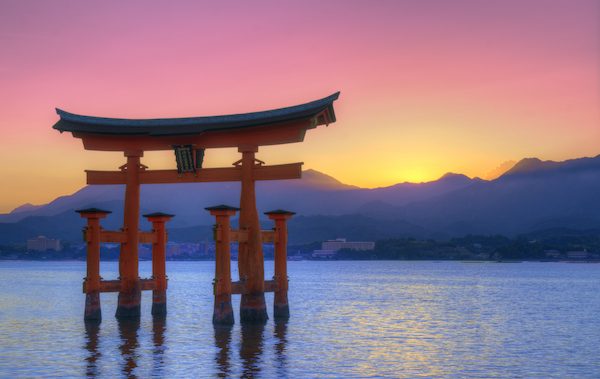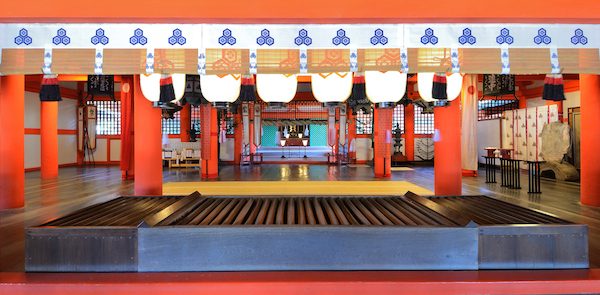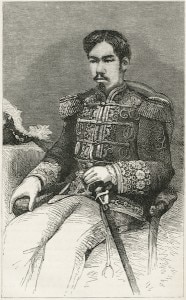How Does the Ancient Shinto Religion Continue to Influence Japan Today

Aizaz Ahmad Khan, Peace Village Canada
Introduction
If Japan's major religions were likened to a tree, Shintoism would be its roots. Shinto, commonly defined as, 'Japan's indigenous religion', is as old as Japan itself.[1] Its roots and origins trace back to the latter part of the Stone Age, when it is said that the Japanese first began inhabiting the Japanese Islands.[2] The ancient Japanese clan Yamato initially believed in Shinto only as a tribal religion but, as they grew in number, proceeded to propagate it as a means to establish and solidify their reign.[3] Since those ancient times, Shinto has been influenced by an influx of various religions into Japan from surrounding regions. The notable arrival of Buddhism into Japan in the 6th century CE had a significant impact on Shinto doctrine; thus, it was only to distinguish itself from Buddhism that the term Shinto was initially coined. Consequently, most Japanese (85 percent) culturally practice a mixture of Shintoism and Buddhism.[4] Globally, up to 3 million people recognise themselves religiously as Shintoists and although Shinto rituals are still widely practiced throughout Japan, only a minority of Japanese identify exclusively with it.[5] Nevertheless, Shinto beliefs and practices are firmly embedded in the civilisation of Japan and continue to remain an integral part of Japanese culture today.

Core Beliefs
- Concept of Kami (God)
At the heart of Shinto ideology is the concept of the Kami, commonly defined as, 'gods' or 'deities'. Heavenly deities, most notably the sun goddess Amaterasu Omikami, are primarily treated as Kami, but the wider scope of the concept also recognises objects of reverence to be acknowledged as objects of worship; such as illustrious ancestors, forces of nature, animals, and even rocks.[6] The Kami are seen as beings who exhibit qualities of harmony and cooperation and who assist people in accomplishing their objectives.[7] Thus, Shintoists seek and worship the respective Kami who are particular to their needs and wishes.
- Creation Myth and Rituals
Shinto beliefs and rituals are founded mainly upon creation myths surrounding the birth and development of the sacred Japanese Islands. It is said that Izanagi and Izanami (Heaven and Earth) were a pair who gave birth to the Japanese Islands and various deities. The sun goddess Amaterasu was produced from the left eye of Izanagi and the moon god Tsuki Yomi from his right.[8] The principles of progress and a harmonious life were understood through the actions of such Kami and, having perceived the existence of a life-force, ancient ancestors of the Japanese developed a sense of the functioning and blessings of the Kami. As such, they were deemed individually endowed with divinity and the ability to respond to prayer.[9] Since these ancient times, offerings are presented to the Kami at Shinto shrines all throughout Japan and religious vows are taken in order to secure some natural benefit, or to give thanks for something already received.[10]
Philosophy and Moral Precepts
Shinto places great emphasis not only on personal virtues such as loyalty and honesty, but also on achieving "makoto no kokoro" ("a heart of truth"). As a basic attitude towards life, it is generally considered more important to achieve purity of heart, upon which one's personal virtues are naturally manifested.[11] Shinto philosophy and teachings were influenced and shaped by the arrival of Confucianism and Buddhism into Japan. Confucian philosophy is compatible with Shintoism, therefore allowed both to coexist in a diffused form.[12] Alternatively, in the case of Buddhism, it is said that initially Shintoism merely gave shelter to Buddhism, only to have its house entirely occupied by the latter.[13]
Sacred Scriptures
Although Shintoism has no officially recognised scripture, two notable books are regarded as sacred due to their historical value i.e. Kojiki (Record of Ancient Matters) and Nihon Shoki (Chronicles of Japan). The earliest existing manuscripts of these books date back to 712 and 720 CE, respectively, and both are compilations of ancient Shinto's oral traditions, mythology, and folklore.[14] No ancient scripture exists which documents or verifies the religious teachings of Shinto. The Kojiki and Nihon Shoki convey the details surrounding Shintoism's creation myth in the birth and establishment of the Japanese Islands, but both seem to differ radically in elements of the narrative. The earlier Kojiki is never quoted in the Nihon Shoki and it is unknown why Nihon Shoki was compiled so soon after Kojiki.[15] Other than the Kojiki and Nihon Shoki, approximately twenty books are also deemed significant due to their documentation and preservation of historical records, outlining key events in the history of Japan and achievements of various Japanese emperors.[16]
Significance of Emperors

© Stocksnapper | shutterstock.com
The Emperor and ruler of Japan holds a significant rank in Shintoism. According to early Shinto mythology, the Emperor was previously regarded as divine because he was a representative of the Kami and a conveyer of their words.[17] A descendent of the sun goddess Amaterasu, named Jinmu (alt. Jimmu), is said to have become the first human Emperor of Japan. Folklore depicts that Jinmu inherited the magical powers and sacred treasures of the Kami and carried out the task of unifying the Japanese Islands.[18] All subsequent emperors in Shinto history have been direct descendents of Jinmu. Currently, Emperor Akihito is the 125th emperor to rule Japan. He ascended the throne in 1989, makes no claim to divinity, and is known as 'the symbol of the State and of the unity of the people.'[19]
Shrines
Today, people visit Shinto shrines at their own convenience but usually do so on occasions of rites and festivals, seeking blessings of the Kami. Various Shinto rites of passage are observed in Japan and at each occasion, beginning from birth up until marriage, shrines are visited to give thanks for the Kami's protection and to pray for prosperity. The Japanese usually hold weddings in Shinto style and pronounce their wedding vows to the Kami. Each Shinto shrine also has several festivals throughout the year, which usually include purification rites, prayer, ritual music and dance, and feasts.[20]
The most significant Shinto shrine in Japan is the Grand Shrine of Ise. It is the chief place of worship of the sun goddess Amaterasu.
Conclusion
Shintosim has forever been a part of the Japanese civilisation, so much so that a study of its development over thousands of years can rightfully be considered reflective of the history of Japan itself. It beautifully teaches its adherents a philosophy of morals that removes human evils and vices from the root. Shintoism is an optimistic faith and the fact that Shinto itself has endured the test of time in Japan defends and maintains this outlook.
Endnotes
1. Mark Teeuwen and Bernhard Scheid, "Tracing Shinto in the History of Kami Worship," Japanese Journal of Religious Studies 29, no. 3/4 (2002): 196
2. Miyaji Naokazu, "What is Shinto?," Contemporary Religions in Japan 7, no. 1 (1966): p.40.
3. Ayaz Najeebullah. "Introduction to Japan's Major Religions," Alfazl Daily, 14 March 2013.
4. Ayaz Najeebullah. "Introduction to Japan's Major Religions," Alfazl Daily, 14 March 2013.
5. "The Global Religious Landscape: A Report on the Size and Distribution of the World's Major Religious Groups as of 2010," Pew Research Center (2012), 40,.
6. Norman Girardot, "Shinto," Encyclopedia of World Religions (Chicago: Encyclopedia Britannica, 2006) 630.
7. Naofusa Hirai, "The Principles of Shrine Shinto," Contemporary Religions in Japan 1, no. 1 (1960): 42.
8. Edmund Buckley, "How a Religion Grew in Japan," The Biblical World 25, no. 3 (1905): 174,176.
9. Naofusa Hirai, "The Principles of Shrine Shinto," Contemporary Religions in Japan 1, no. 1 (1960): 42-43.
10. Edmund Buckley, "How a Religion Grew in Japan," The Biblical World 25, no. 3 (1905): 176,178.
11. Norman Girardot, "Shinto," Encyclopedia of World Religions (Chicago: Encyclopedia Britannica, 2006), 1000.
12. Hazrat Mirza Tahir Ahmadrh, Revelation, Rationality, Knowledge and Truth (Tilford, UK: Islam International Publications, 1998), 153.
13. Miyaji Naokazu, "What is Shinto?," Contemporary Religions in Japan 7, no. 1 (1966): 44.
14. Norman Girardot, "Shinto," Encyclopedia of World Religions (Chicago: Encyclopedia Britannica, 2006), 998.
15. John Breen and Mark Teeuwen, A New History of Shinto (Chichester: Wiley-Blackwell, 2010), 30.
16. Ayaz Najeebullah. "Introduction to Japan's Major Religions," Alfazl Daily, 14 March 2013.
17. Naofusa Hirai, "The Principles of Shrine Shinto," Contemporary Religions in Japan 1, no. 1 (1960): 46.
18. Norman Girardot, "Shinto," Encyclopedia of World Religions (Chicago: Encyclopedia Britannica, 2006) 999.
19. Mark Teeuwen and Bernhard Scheid, "Tracing Shinto in the History of Kami Worship," Japanese Journal of Religious Studies 29, no. 3/4 (2002): 168-169.
20. Norman Girardot, "Shinto," Encyclopedia of World Religions (Chicago: Encyclopedia Britannica, 2006) 1000-1001.
Source: https://www.reviewofreligions.org/10622/shintoism-in-japan/
0 Response to "How Does the Ancient Shinto Religion Continue to Influence Japan Today"
Post a Comment